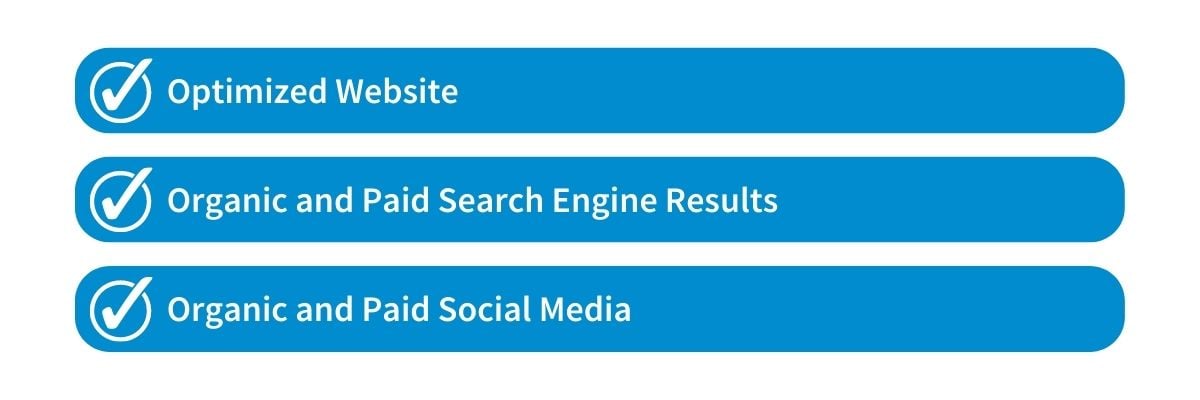Marketing SaaS products has always been challenging, and the industry is only growing more competitive. Grand View Research forecasts a growth rate of 11.2% between 2022 and 2028. More opportunities attracts more competition, so what can you do to ensure your SaaS company stands out? Here are a few actionable steps you can take:
- Understand what makes marketing SaaS products uniquely challenging and how you can turn those challenges into advantages
- Mix different promotional channels to ensure you connect with your audience where they are
- Take advantage of the available tools to make planning and executing your marketing strategy more efficient and effective
- Create a pillar network of helpful SaaS content that answers the questions your audience is searching for
In this article, we show you how to get it done. Let’s dive in.
What Is SaaS Marketing and How Is SaaS Marketing Different?
SaaS marketing is a combination of tactics that B2C and B2B SaaS companies use to achieve specific organizational goals such as building brand awareness, converting new customers, and upgrading existing users. SaaS marketing is different from the marketing used in many other industries, facing unique challenges that include:
- Promoting an Intangible Product: Marketers can promote food through taste and smell, cars with test drives, and SaaS products with… key performance indicators (KPIs). While KPIs are essential to tracking business performance, they don’t have the smell of a mouth-watering burger or a smooth ride with heated seats. SaaS marketers are tasked with building the same enthusiasm for software that has an unfamiliar user interface and difficulty providing immediate value. In other words, users often have to try your product for an extended period of time before they see the results that make them want to buy.
- Needing to Provide Ongoing Value: The job isn’t over for SaaS marketers once a lead signs up for a paid subscription. Users have frequent opportunities (typically monthly or yearly) to cancel their subscription. To keep customers engaged, you need to prove that your service is delivering impressive, ongoing results. While maintaining subscriptions is important, it’s also crucial for many SaaS business models to drive upgrades. Customers need to learn about more advanced features so they see the value in spending more on higher-level plans.
- Marketing to Change-Averse Decision Makers: B2B SaaS products are designed to make business processes easier. However, in order to improve a process, there already has to be one in place. That means employees are used to doing their work a certain way, and they may meet managers with resistance who try to overhaul their familiar routines. To effectively market your SaaS product, you have to convince decision makers (who may be change-averse themselves) of its value, and that your product will be easy and exciting to adopt by a group of (likely change-averse) individuals.
The best B2B SaaS companies recognize these challenges and even turn them into strengths. For example, offering free trials or “freemium” accounts can give leads the chance to test-drive your products. Educational content geared toward your existing customers can help them understand how to make the most of your features so they stick around longer and explore your advanced plans. Change is hard, but many businesses are also dealing with cumbersome legacy systems; present your product as the key to simplicity now and in your customer’s future.

How Much Do B2B SaaS Companies Spend on Marketing?
The average B2B SaaS company spends 10% of their annual recurring revenue (ARR) on marketing, according to SaaS Capital. This number is just an average; each SaaS company will have different marketing needs, which will also be influenced by which business stage they’re in. For example, start up companies may benefit from spending closer to 20% of their ARR on marketing to help establish their brand image. By using ARR to base marketing spend off, SaaS companies set their budgets as a portion of existing, ongoing business rather than relying on new business.
Where Can I Promote My SaaS Product?
The internet is an excellent—and essential—tool for promoting your SaaS product. This may seem obvious for many companies, but effectively marketing SaaS products requires more than just a website. According to Gartner, B2B buyers spend 27% of their time conducting independent research online compared to 17% of their time meeting with potential suppliers. In other words, if you’re not occupying as much space as you can online, you’re losing business to your competitors who are. How? Start with the following:

- Website: Having a website is typically the first step to building an online presence, but you need to do more than set-it-and-forget-it to get any real value. In fact, recent research shows that 91% of websites get zero traffic, and of those that do, half get less than 10 visits per month. So what can you do to drive traffic and make sure your visitors want to come back? Some essentials include:
- Optimizing your site for mobile users (nearly 60% of web traffic comes from mobile devices as of November 2022)
- Using images to engage visitors and including alt text to appeal to search engines
- Publishing helpful content using Pillar-Based Marketing to link together blogs that cover related topics
- Search Engine Rankings: One of the best ways to increase traffic to your website is to improve its visibility by ranking on the first page of search results page rankings (SERPs). There are two ways to do this:
- Paid Ads: Paid ads rocket you to the top of SERPs, which can be a great way to gain exposure quickly. However, this method often gets fewer clicks than organic content because searchers can see that you are paying for that space. You also have to pay for that space for the entire time you want to occupy it. With Google cost-per-click prices expected to increase by 20-40% in 2022, many businesses will find paid ads to be unsustainable as their only method of promotion.
- Organic Content: Organic content, or blogs that live on your website, take a little longer to reach page one. The good news is that you don’t have to pay for organic content’s rankings. This makes your blog posts appreciating assets. The longer they are posted for and the more content you create to support each other, the more visibility you’ll earn for your brand without needing constant investment. What are the 3 types of blogs you should be creating? Ultimate guides to give a broad overview of a topic and the different questions that are connected to it, how-to tutorials to show a step-by-step process with your offering as the solution, and frequently asked questions with in-depth answers to specific questions within a topic.
- Social Media: Social media platforms give you the opportunity to build a loyal audience made up of your target demographic. These platforms are also a great way to share your blog posts or other original content like photos, videos, and customer testimonials. With boosted posts, you can pay to expand your reach and connect with users outside of your current audience. Social media ads also have advanced targeting features. For example, with LinkedIn, you can target based on company size and job position, making it easier to connect with decision makers.
An effective B2B SaaS marketing strategy recognizes that each tactic has its own strengths and combines a variety to reach their audience at different stages in the buying journey. For example, you can promote your blog on your social media pages to attract more readers. As that blog rises through the ranks, you can pay for Google Ads to get your brand out there quickly.
What Is SaaS Marketing Technology?
SaaS marketing technology refers to any software or platform that enables you to run your digital marketing strategy for SaaS and analyze your results. This technology can be used for specific tasks such as:
- Customer Relationship Management: Track and evaluate customer health to see who is ready to upgrade and who is at risk of churning with tools like HubSpot, Salesforce, and monday.com.
- Keyword Research and Content Creation: Discover which keywords you need to feature to answer your audience’s questions and rank on search engines with tools like DemandJump.
- Creating Graphics: Prepare eye-catching graphics for email newsletters, social media posts, digital ads, blogs, and more with tools like Canva, Affinity, and Adobe Photoshop.
- Paid Ads Management: Design ads, target your specific audience, set your metrics for success, and control your budget with tools like LinkedIn Ads, Facebook Ads, and Instagram Ads Manager.
- Social Media Management: Plan your social content in a calendar, track trending topics, and schedule posting with tools like Hootsuite, SocialPilot, and Loomly.
- Track Performance: Gain insight into customer behavior, track ROI on your paid ads, optimize marketing performance, and share reports with tools like Google Analytics, Whatagraph, and Supermetrics.
What Is SaaS Marketing Automation?
SaaS marketing automation technology carries out the tedious tasks so your experts can focus their creative energy on more pressing matters. Most aspects of your strategy will have at least some tasks that can be automated.
For example, you can automate email drip campaigns to start after a customer completes an action that shows intention, such as adding an item to their cart from your eshop or signing up for your newsletter.
Automation isn’t just for more tedious tasks, however. Sometimes, technology can work faster and more accurately than people on complex assignments. Consider keyword research and how long it would take a team of researchers to comb through countless pages of Google search data to develop a content topic cluster. With DemandJump, you can have a thorough list of high-value keywords, the terms your competitors are ranking for, and which topics you should cover with interlinked blogs—all in a matter of minutes.
Take the Guesswork Out of SaaS Marketing
Time is money. When it comes to reaching out to your target audience, covering the wrong topics will likely fail to grasp your audience’s attention, which wastes both time and money. Fortunately, with a tool like DemandJump, you can discover exactly which topics your ideal customers are searching, so you know what to write about to connect with them.
As the first and only Pillar-Based Marketing platform, DemandJump does more than just tell you which terms and questions people are searching. It also shows you the relationships between those terms to help you build a pillar network of interlinked blogs that tackle related questions and support each other as they climb higher on SERPs.
If you aren’t satisfied with the results you’ve been seeing when marketing your business, it’s time for a change. Get started and see the difference that intentional content marketing can make.











